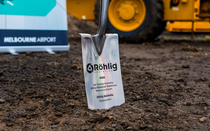Dear Valued Customer,
Welcome to the Röhlig Australia Market Update - April 2023. We will continue to be in contact with you, letting you know what is happening in the world of freight forwarding and logistics. If you have any questions and would like to address them, please send them to rohlig.australia@rohlig.com. We appreciate your suggestions and feedback.
Please click the drop-down sections below to read the update for AIR, SEA ,CUSTOMS and TRANSPORT.
Oceania
April and May are continuing the status quo on flight availability from our last newsletter, although we are seeing plans for additional American routes and additional wide-bodies for Trans-Tasman later in May. Rocky passenger demand may be turning a corner based on forward route planning, a positive sign for the industry.
The expected US Fed decision to kick the can down the road on their debt ceiling will restore some market and business confidence, with incoming quantitative easing likely (again). Unfortunately, that means for us that stubborn inflation will probably hang around and keep airfares high and route optimisation (flight cancellations) a thing for a while.
Fleet modernisation is a hot topic at the moment, both because nothing happened for 3 years during the pandemic, and also because newer aircraft cost less per hour to run. This is good for freight, as it means transitioning to lighter airframes that are more fuel efficient and, therefore, can handle more cargo at less cost. You can read the article, which also happens to have quite the sensational title.
Read more: Alan Joyce accused of ‘leaving a financial mess’ for next Qantas CEO
Despite all the gloominess, it’s becoming a better time to ship air-cargo, with rates ex Europe, Asia and the Americas all seeing significant drops. We are not pre-covid yet, however, it’s certainly easier to breathe compared to 6 months ago. The drops are still very correlated with increasing passenger aircraft, with our Sydney benchmark running at 90 or so flights per day, now 25% down on pre-covid flight numbers.
Read more: Flying on the world’s best first class airline, Singapore Airlines
Oil and Jet fuel prices
Oil and jet fuel continue on an overall downward trend from the peak in June last year, however our friends at OPEC are doing their best to combat the decline with significant production cuts, with a production cut the day after our last newsletter
Read more: OPEC+ announces surprise oil output cuts
This corresponded with a fairly rapid 30% jump in barrel pricing, from the 64 dollar low to 84 dollars. That hasn’t stopped us settling back down to 74 USD at the time of writing, as demand just isn’t there to sustain plus 80 USD barrel prices. So good – cheap fuel, bad – economic demand is low.
( See Oil Chart and Oil vs Jet fuel in the PDF file).
Australia
We are in a rough patch for Trans-Tasman space until mid-May, when more wide-bodies will be put back into the market. Delays are minor if they happen, though we will welcome those triple 777’s and A330’s inbound.
Outbound elsewhere, rates are good on direct routes, as airlines look to fill the cargo in-balance with any KG they can.
New Zealand
In reference to the Australia’s update, Trans-Tasman is stable if a little congested on the weekends, though additional wide-bodies are inbound mid-May.
Europe and the Americas are still stubbornly high for New Zealand, however, we have started to see some spot rates emerge for certain routes, which gives some encouragement that we will see large rates drops soon.
Asia
The Chinese spot market is keeping us on our toes, with rates having an incredible variance depending on what is flying and when. There is no end in sight to these fluctuations, not until lower rates become the normal rate, which is hopefully this year.
Thailand and Malaysia continue from last month with lower rates, in particular Malaysia which is a great alternative to cargo from Singapore and Thailand. Reach out to your local account manager for a quote.
USA
Finally, some decent relief from the USA on rates, as more and more passenger flights have put downward pressure on most routes to Australia and New Zealand. In particular, the west coast options have opened up for any cargo west of the rocky mountains.
Europe
Bit by bit we’ve been chipping away at European rates, as carriers wake up to the developing space situation and reluctantly move down from established covid rates. The rate of decline has slowed, though there is room for more downward pressure if we can increase those inbound passenger numbers.
There are now ’B service’ options in the market, particular via Asia, if you have time to wait. With rates sliding on major carriers as well, we recommend avoiding anything listed with a 5 day airport to airport transit, as these have been taking much longer through their transit hubs.
For more information about our Air Freight services, please click Rohlig Air Freight.
Oceania
New services have been announced in the Trans-Tasman market bringing on new capacity from Australia to New Zealand. Commencing in May, COSCO and NPDL have each announced new fortnightly services deploying one x1100TEU ship and three x1700TEU vessels, respectfully. COSCO’s service is a little unexpected, calling Melbourne then Bell Bay (but not offering Coastal), Sydney then Auckland. NPDL will offer a service rotation starting in Sydney then Melbourne, Auckland before moving across the Pacific to Fiji ports.
Asia
There are few positive developments on the Asia to Oceania trade from the last update. Rates continue to drop to unprecedented levels in the last few weeks. Low consumer demand, increasing interest rates and economic uncertainty continue to drive the market downward which has flow on effects impacting services and capacity. ANL have this week temporarily suspended their A3X service citing low market demand, effectively pulling capacity out of the China to AU market.
Furthermore, escalating geopolitical tensions in the region have seen businesses shift to production outside of China, exploring alternatives in South East Asia. This amplifies the uncertainty in the world’s supply chains with major corporations exploring opportunities in recent years.
ANZ Port Congestion
In Auckland the MT depot congestion has got a lot better. However, the flow-on effects from the recently enforced port berthing windows has resulted in several vessels changing their port calling rotations. This is to minimise vessel downtime, avoid extended waiting time and assist with schedule recovery. As a result, some vessels omitting NZ main ports.
Europe
Demand for European cargo to Oceania continues to be soft as customers’ inventories and stock levels remain high. Carriers hope the depletion of these will lead to a pick-up in demand and bring them a boost for the peak season. However, there has been little improvement in the economic situation both overseas and at home, which makes anticipating a typical peak season this year unlikely at this stage.
Rate levels show no signs of stabilising on this trade with a number or reductions in quick succession in a relatively short period of time. Capacity and equipment remain open for the most part, depending on shipping line. Transhipment services still being the preferred service over direct sailings.
Global
Bunker prices took a steep dive in Q4, 2022 and found a relative, but still somewhat volatile balance in Q1’23. Our expectations are that the Bunker price will remain in Q2’23 around the USD 600 / Ton (+/- 10%).
Read more: Global 4 Ports Average Bunker Prices - Ship & Bunker (shipandbunker.com)
Ports of Singapore, Long Beach, and Los Angeles Sign Green Shipping Corridor Pact
“The Maritime and Port Authority of Singapore (MPA), Port of Long Beach, and Port of Los Angeles, along with support from C40 Cities, signed a memorandum of understanding to establish a green and digital shipping corridor.
The purpose of the corridor is to support the decarbonization of the maritime industry and improve efficiencies through digitalization. The signing of the memorandum was witnessed by various leaders from Singapore and the United States.”
Read more: Ports of Singapore, Long Beach, and Los Angeles Sign Green Shipping Corridor Pact (gcaptain.com)
(Please download PDF file to see charts).
Brown Marmorated Stink Bug - End of Season
BMSB Seasonal Measures will end on the 30th April.
Meaning BMSB high risk cargo with a “shipped on board” date after the 30th April will not require BMSB treatment.
The 2023/24 Season Measures are yet to be announced, however we expect they will return on the 1st of September 2023.
For more information: Seasonal measures for Brown marmorated stink bug (BMSB) - DAFF (agriculture.gov.au)
Khapra Beetle measures
With more trade created from the new India-Australia free trade agreement, it is a timely reminder to mention the Departments Khapra Beetle requirements for FCL/ FCX containers.
Khapra beetle target risk container’s MUST be treated offshore.
A target risk container is defined as a Full Container Load/ Full Container Consolidated (FCL/FCX) where:
- high risk plant products packed into the sea container in a khapra beetle target risk country
- other goods are packed into the sea container in a khapra beetle target risk country and destined to a rural grain growing area of Australia.
More information can be found HERE.
Cartage/transport
Fuel prices nationally have slightly decreased in Victoria and Brisbane which will be passed on. At this stage there are no further movements from the other states.
Storage space is slowly getting better with some more options becoming available but most of the larger storage facilities are still at capacity.
Thank you for your ongoing support of Röhlig Australia and New Zealand. We will continue to keep you updated, however should you have any questions relating please do not hesitate to contact your Röhlig Account Manager or Customer Service Representative.
DISCLAIMER - All information is provided in good faith for guidance and reference purposes only. It is of a general informational nature, and Röhlig Logistics GmbH & Co. KG takes no legal responsibility for the accuracy of the information provided via this document. Röhlig Logistics GmbH & Co. KG makes no representation as to the accuracy or completeness of any of the information contained herein and accepts no liability for any loss arising from the use of the information provided.









